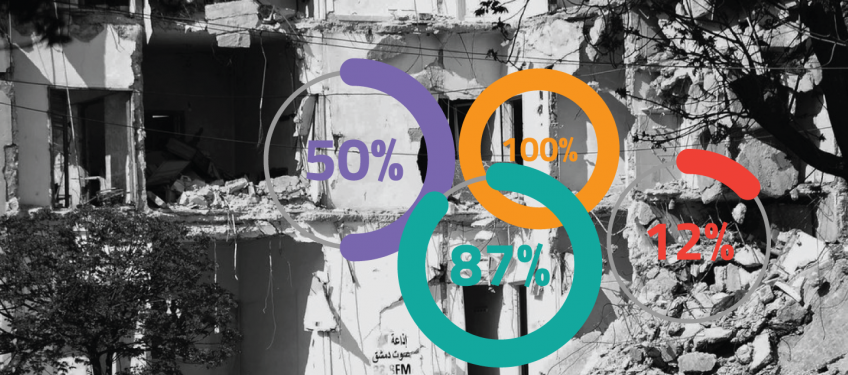
Since mid-March 2011 up until April 2017, VDC documented 175,545 battle-related deaths.
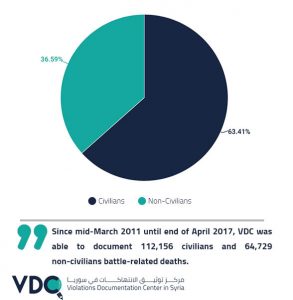
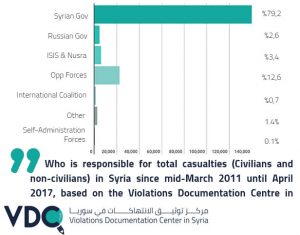
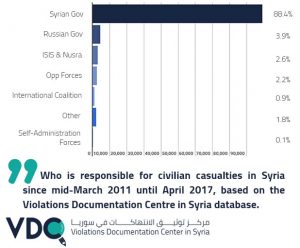
April Battle-Related Deaths:
During this month VDC documented a total of 1165 deaths across different Syrian governorates, among them, 1110 were documented by full name and 55 are still registered as unknown.
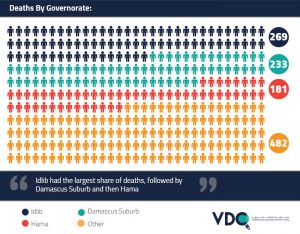
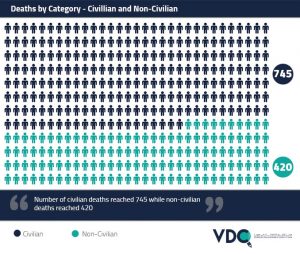
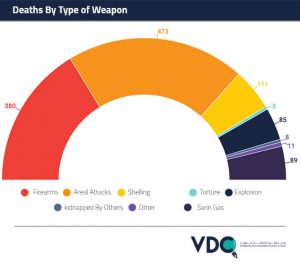
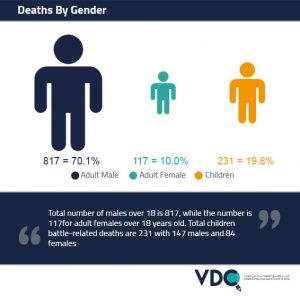
Death by Type of Weapon:
380 of the total 1165 of the battle-related death occurred by firearms and snipers, 473 by aerial attacks and barrel bombs, while tanks, cannons and mortars accounted for 111 battle-related deaths, and the attack with Sarin gas accounted for 95 deaths. Additionally, the VDC documented the deaths of 112 under other reasons; 8 deaths under torture in the Syrian government detention centers and 85 by land mines and car explosives, 8 kidnaped by unknown. While for the rest 11 the cause or the executioner was not undoubtedly identified.
Deaths by ISIS:
During this month, VDC documented the death of 78 people, 52 are civilians, and 26 from different armed groups.
Aerial Attacks on Idlib Province during April 2017
Chemical Attack on Khan Sheikhoun in Idlib Province:
On the 4th of April, 2017 at 07.00 in the morning, Khan Sheikhoun in Idlib was bombed by nearly 15 aerial attacks that targeted the town’s center with different ammunition. One of the air raids included poisonous gas that resulted in the injury of tens of civilians. The symptoms that appeared on the injured suggests the use of Chlorine and Sarine gasses as a weapon by the Government forces in that attack. The assault resulted in the death of 95 people according to the documents of the VDC, in addition to the documentation of 541 cases of choking and medium and extreme poisoning according to the Health Directorate of Idlib Province. (1)
According to the VDC’s information, the Syrian government had used internationally prohibited chemical weapons during these airstrikes, which is considered to be a war crime and a breach of the Geneva protocol 1925 that prohibits the use of chemical and poisoning weapons during war, in addition to breaching the Chemical Weapons Convention that the Syrian Regime joined as of 14-10-2013 which mentioned in its first article: “each state signing of this agreement shall not use chemical weapons under any circumstance”.
- Incendiary ammunition attacks on Idlib Province
April 2017 witnessed a notable increase in the use of incendiary and phosphoric ammunition by the Russian Air Force after a slowdown in using them for several months. This military offensive came days after the chemical attack on Khan Sheikhoun. Additionally, several towns and villages in Aleppo, Hama, Idlib and Damascus Suburb were targeted with incendiary and phosphoric ammunition since the beginning of April 2017.
During April 2017, VDC teams were able to document 36 aerial attacks conducted by the Syrian government and the Russian Air Force where phosphoric and incendiary ammunitions were used. 22 of these attacks targeted civilian areas and neighborhoods: 11 civilian targets in Idlib, 8 civilian targets in Aleppo Suburb, in addition to 3 civilian targets in Hama Suburb. Video 01 and video 02.
As a result of the density of these attacks, areas targeted by phosphoric cluster bombs and incendiary ammunition witnessed a relative internal displacement in addition to the destruction of infrastructure and properties.
The basics of international law for human rights regulate the use of weapons that contain white phosphorus. These laws demand conflicting parties of differentiating between military and civilian targets and civilians, and the international law expects these parties to take all the needed measurements to ensure the safety of civilians and civilian targets during military operations. Attacks that result in the destruction of civilian targets and civilians indiscriminately are prohibited.
Russia is a member in the Chemical Weapons Conviction that prohibits the use of incendiary ammunition in areas with dense population, Syrian Government, on the other hand, did not sign on this protocol.
Indiscriminate attacks on civilians are a severe breach of human rights international law according to the human rights convention, and are therefore considered to be a war crime where officials responsible for giving the orders of these attacks would face criminal offense charges, in addition to everyone who committed, facilitated or assisted in the execution of these orders.
Notes:
These figures are not final in any way, and they are subject to continuous and periodic scrutiny by center’s activists, the database administrators, and the field documentation team. Figures may differ between reports, and the most recent report is always considered to be the more accurate.
VDC team pays tribute to all the collaborative activists who extended a helping hand to our center as well as to the families of the victims. We also thank the Field Observation Team whose members face daily dangers executing their duties in Syria in order to document the human rights violations committed there, complete the data, and claim the rights of the distressed families from the concerned bodies and organizations.


